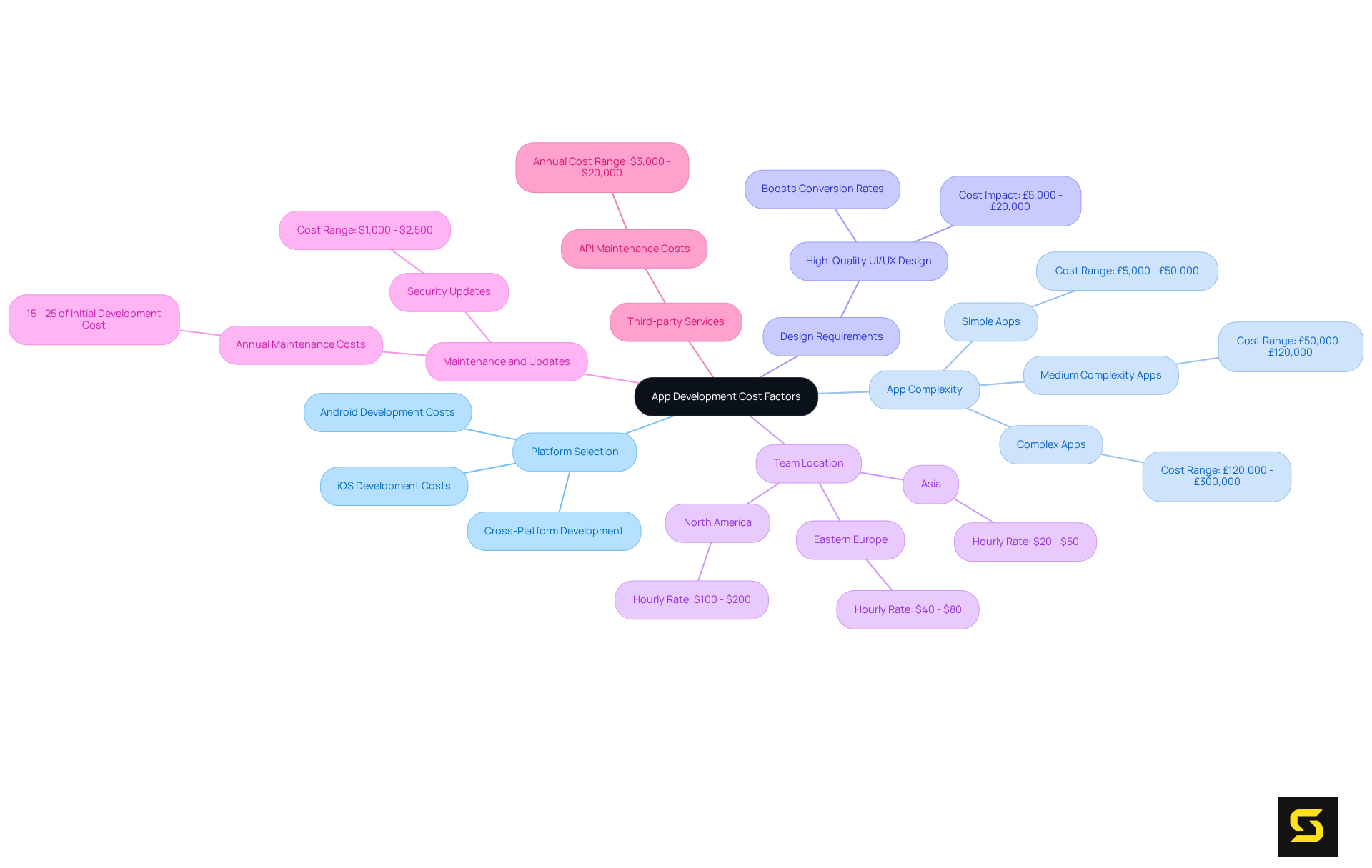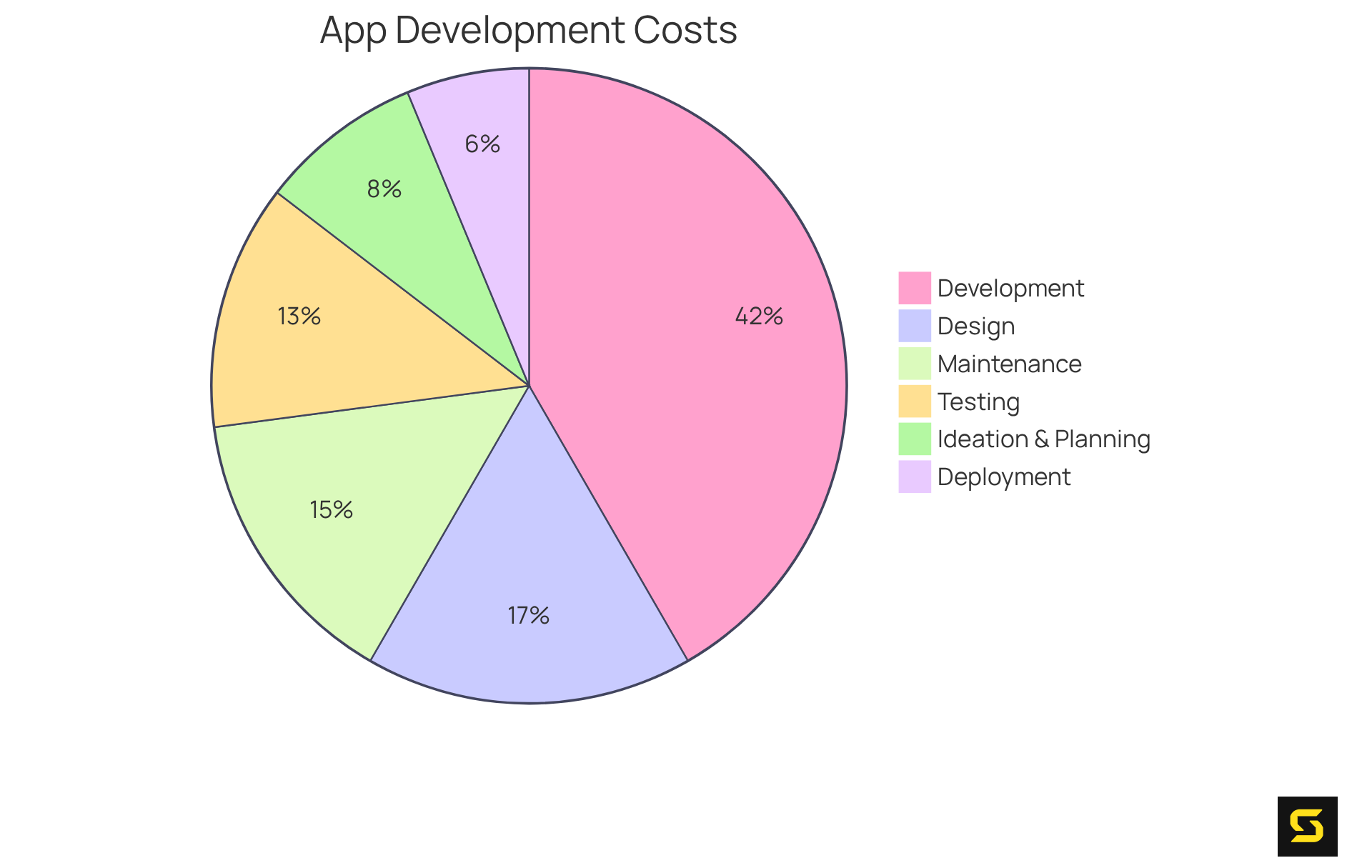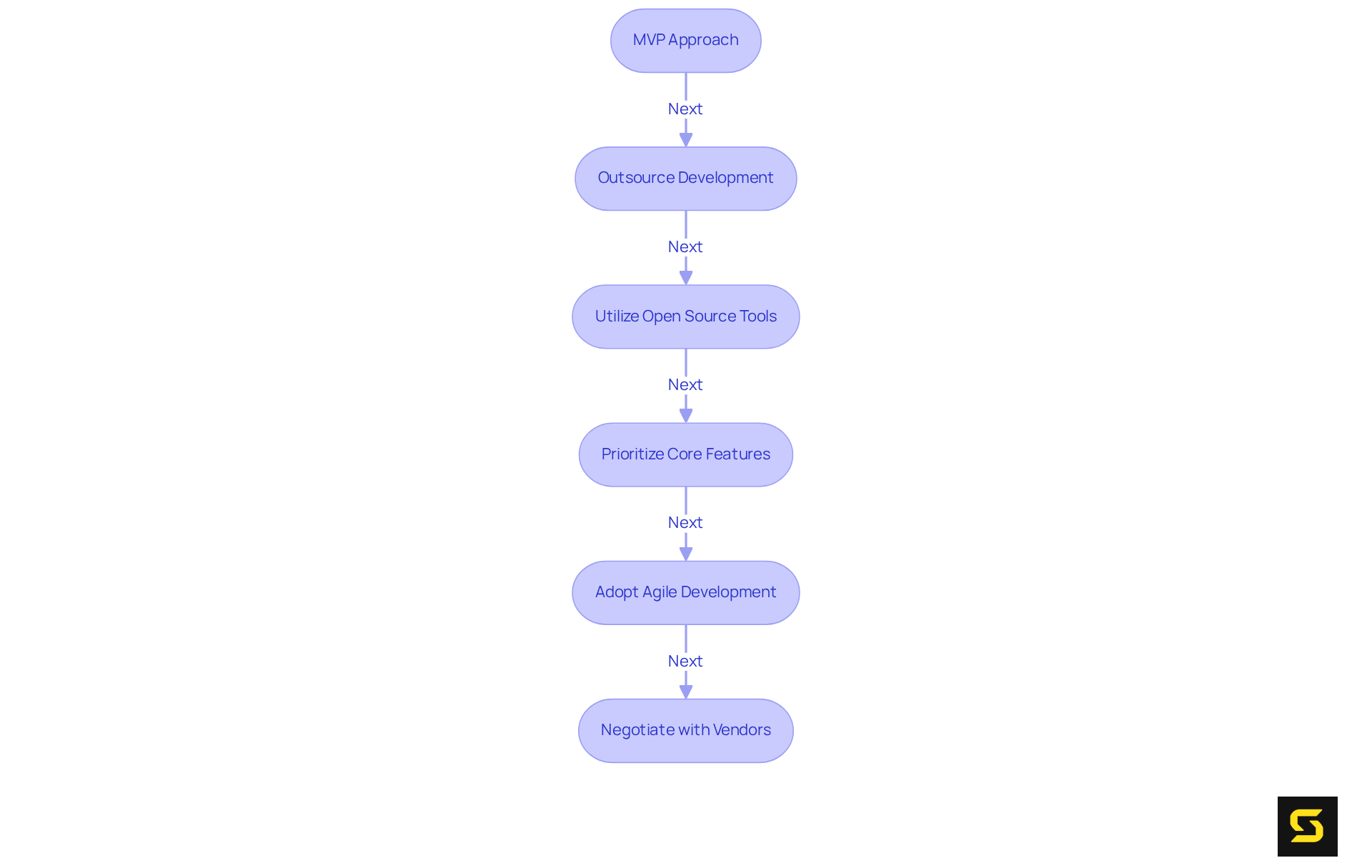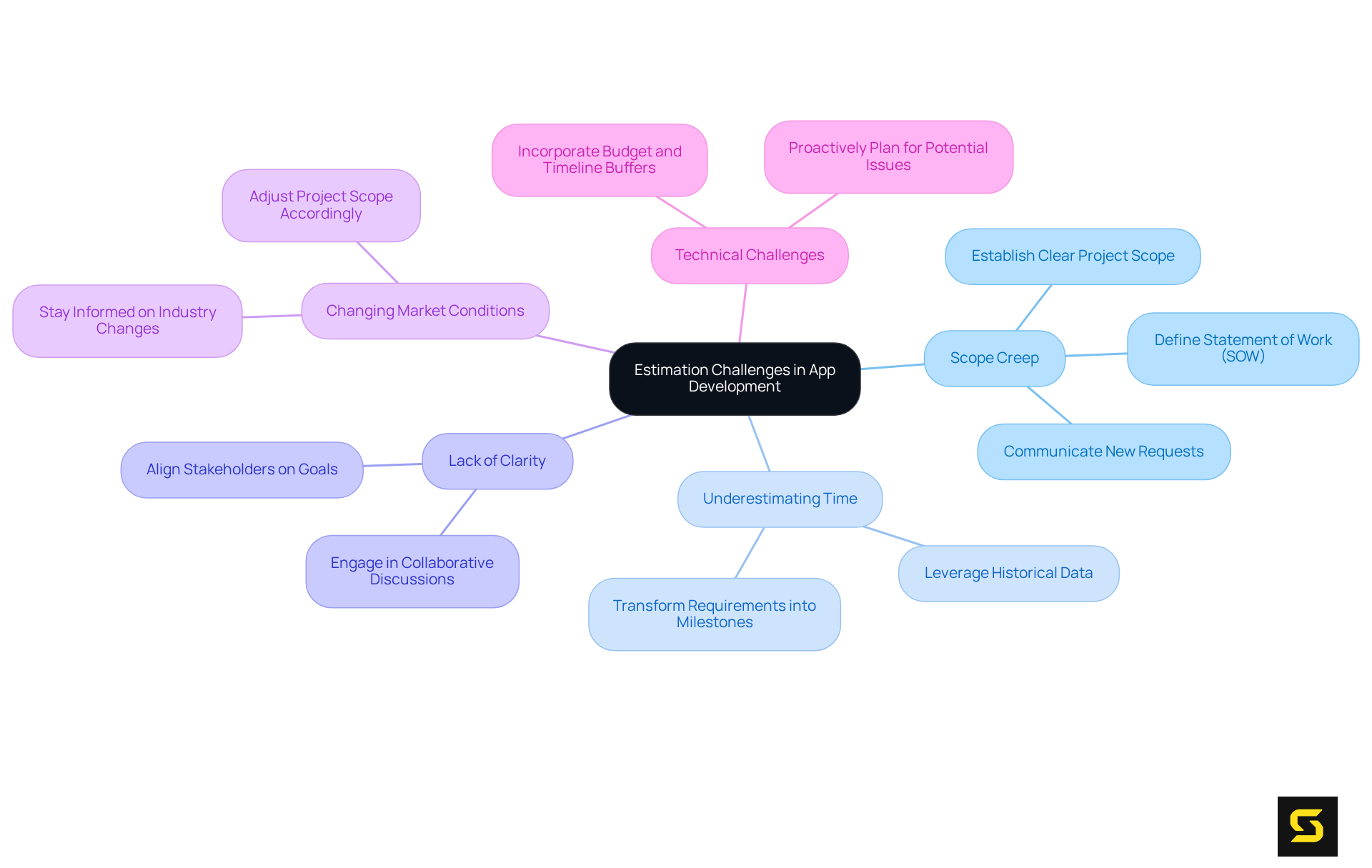Overview
The cost of creating an app is significantly influenced by several key factors:
- Platform selection
- App complexity
- Design requirements
- Team location
- Ongoing maintenance
Understanding these elements is crucial for managing expenses effectively. Careful planning and strategic approaches, such as outsourcing and prioritizing core features, can substantially reduce costs. By adopting these strategies, businesses can navigate the complexities of app development with confidence, ensuring they allocate resources wisely and achieve their desired outcomes.
Introduction
Navigating the financial landscape of app development resembles traversing a labyrinth, where numerous factors intricately influence the final cost. From the critical choice of platform to the nuances of design, each component plays a pivotal role in shaping the overall budget.
As aspiring developers and entrepreneurs endeavor to create innovative applications, a crucial question emerges: how can one accurately estimate the costs involved while ensuring both quality and functionality?
This article explores the essential factors that impact app development expenses, offering insights and strategies to empower you in making informed financial decisions within this dynamic industry.
Understand App Development Cost Factors
When evaluating the cost of app development, several critical factors must be considered:
- Platform Selection: The choice to create for iOS, Android, or both greatly affects expenses. Each platform has distinct creation requirements, with iOS typically incurring higher expenses due to its premium market positioning. Starting in 2024, the expenses for creating applications on both platforms are nearly identical, with complexity being the main factor influencing how much does it cost to create an app. However, it is important to note that how much does it cost to create an app on iOS programming generally incurs higher rates, which can significantly impact your budget.
- App Complexity: The intricacy of the app plays a crucial role in influencing development expenses. Advanced features such as real-time data processing, integrations, and artificial intelligence can significantly influence how much it costs to create an app. For instance, a full-fledged SaaS app in a major market like San Francisco could range from $300,000 to $500,000, depending on its complexity. Moreover, complex apps with advanced features can require investments ranging from £100,000 to £300,000 or more, which provides insight into how much does it cost to create an app.
- Design Requirements: Tailored UI/UX design is crucial for user engagement and can significantly raise total expenses. High-quality design can boost conversion rates by up to 400%, which raises the question of how much does it cost to create an app, but it remains a worthwhile investment. It is vital to acknowledge that although premium design can increase expenses, it is necessary for success in a competitive market.
- Team Location: The geographical position of your group significantly influences labor expenses. For example, developers in North America charge between $100 and $200 per hour, while those in Eastern Europe may charge significantly less, ranging from $40 to $80 per hour. This disparity can lead to substantial savings without compromising quality, making it an important consideration in evaluating how much does it cost to create an app during your budgeting process.
- Maintenance and Updates: Post-launch support and regular updates are ongoing expenses that should be included in your budget. When considering how much does it cost to create an app, it's important to note that yearly maintenance for mobile applications generally falls between 15% and 25% of the initial development expenditure, encompassing bug fixes, security updates, and performance monitoring. This is a crucial detail for budgeting, as it ensures that you allocate sufficient resources for the app's longevity.
- Third-party Services: If your app requires third-party integrations, such as payment gateways or APIs, these can incur both initial and ongoing expenses. For instance, annual maintenance for third-party APIs can range from $3,000 to $20,000, depending on the complexity and number of integrations. Understanding how much does it cost to create an app is essential for precise financial planning.
By understanding these elements, you can establish a more precise financial plan and schedule for your app creation project, ensuring that you distribute resources efficiently and enhance your return on investment.

Break Down Costs by Development Stages
The application development process encompasses several essential phases, each with unique expenses that can significantly impact your budget, raising the question of how much does it cost to create an app. Understanding is crucial for effective financial planning.
- Ideation and Planning: This foundational phase involves brainstorming ideas, conducting market research, and defining the app's purpose. Expenses in this stage can range from $4,000 to $20,000, depending on how much it costs to create an app, as well as the complexity of the project and the need for external consultants or surveys. Engaging in meticulous planning can mitigate expenses later by ensuring the app meets user requirements effectively. Notably, the planning phase accounts for approximately 10% of the overall expense of app creation, with the discovery stage ranging from $4,500 to $8,000. As Joe Tuan articulates, 'How much does it cost to create an app is determined by the scope of the project, including app complexity, design specifications, and post-launch upkeep.'
- Design: UI/UX design is pivotal in fostering user engagement and satisfaction. The expenses for this phase typically represent 15-25% of the overall development budget, fluctuating based on design complexity and the expertise of the design team. Investing in high-quality design can lead to enhanced user retention and reduced long-term costs.
- Development: This phase is generally the most expensive, consuming about 40-55% of the total budget. Expenses here depend on the number of features, the chosen technology stack, and the rates of the programming team. For instance, programming alone can account for 50-70% of the overall expenses, highlighting how much does it cost to create an app and the importance of meticulous budgeting.
- Testing: Quality assurance is vital to ensure the app functions correctly and meets user expectations. Testing expenses can vary from $8,000 to $18,000, encompassing the recruitment of QA specialists and the utilization of testing tools. Involving QA early in the development process can significantly reduce costs related to bug fixes.
- Deployment: Launching the app entails expenses associated with app store fees and marketing efforts. Deployment generally requires an allocation of around 5-10% of the overall budget, which may include promotional activities to enhance visibility.
- Maintenance: Post-launch, ongoing maintenance and updates are essential to keep the app functional and relevant. Maintenance expenses are projected to be 15-20% of the initial creation cost each year, covering bug fixes, security updates, and performance monitoring.
By analyzing the expenses related to each phase, you can more effectively manage your budget and set realistic expectations about how much does it cost to create an app.

Implement Cost-Reduction Strategies
To effectively manage app development costs, consider implementing these strategic approaches:
- MVP Approach: Begin your project with a Minimum Viable Product (MVP) to validate your concept through essential features. This strategy allows for early user feedback and iterative improvements, which can help to determine how much does it cost to create an app while minimizing significant upfront expenses. DevsData offers rapid development services for MVPs, enabling businesses to test their ideas swiftly and efficiently.
- Outsource Development: Leverage the benefits of outsourcing to regions with lower labor costs while maintaining quality standards. Businesses often analyze how much it costs to create an app, reporting average savings of 15-30% through outsourcing, which allows for more effective resource allocation. As MyOutDesk states, "Outsourcing is no longer just about saving money—it’s about scaling smarter."
- Utilize Open Source Tools: Capitalize on to streamline the development process, significantly reducing both time and costs associated with building your application.
- Prioritize Core Features: Concentrate on delivering essential functionalities that offer maximum value to users. By deferring less critical features for future updates, you can manage your finances more effectively, particularly when evaluating how much does it cost to create an app.
- Adopt Agile Development: Implement an agile methodology to enhance flexibility and enable iterative enhancements. This approach helps prevent costly modifications later in the project cycle, ensuring that your app evolves in alignment with user needs.
- Negotiate with Vendors: When working with third-party services, negotiate pricing or explore alternative solutions that may provide more favorable rates, further optimizing your budget.
By embracing these strategies, you can uphold a high-quality app while efficiently managing your project budget.

Troubleshoot Common Estimation Challenges
Common challenges in estimating how much does it cost to create an app can significantly impact the success of a project. Understanding these challenges is essential for effective planning and execution.
- Scope Creep: This phenomenon arises when additional features are introduced after the project's initiation, resulting in escalating costs. To mitigate this risk, it is crucial to establish a and adhere to it. Additionally, a well-defined Statement of Work (SOW) outlining project milestones and tasks is essential to guide the team and prevent scope creep.
- Underestimating Time: Developers often miscalculate the time required for specific tasks, leading to budget overruns. To counter this, leverage historical data from similar projects to formulate more accurate timelines. Transform project requirements into actionable milestones, complete with estimated time frames and budgets, to enhance planning accuracy.
- Lack of Clarity: Ambiguously defined project requirements can result in miscommunication and unforeseen expenses. It is vital to ensure all stakeholders are aligned on project goals and specifications. Engaging in collaborative discussions with clients can effectively clarify requirements and expectations.
- Changing Market Conditions: Market trends can evolve, influencing the relevance and costs associated with certain features. Staying informed about industry changes allows for timely adjustments to project scope, ensuring that the final product remains competitive in the marketplace.
- Technical Challenges: Unanticipated technical issues may emerge during development. To safeguard against these challenges, incorporate a buffer in your budget and timeline for unexpected obstacles. Proactively planning for potential issues is key to maintaining project integrity and preventing resource over-allocation.
By recognizing and addressing these common challenges, you can significantly enhance your cost estimation process, especially when considering how much does it cost to create an app, and avert potential pitfalls, ultimately leading to more successful project outcomes.

Conclusion
Understanding the cost of app development is crucial for anyone aspiring to transform their mobile application idea into reality. The financial landscape of app creation is influenced by several pivotal factors, including:
- Platform selection
- App complexity
- Design requirements
- Team location
- Ongoing maintenance
By recognizing these elements, developers and entrepreneurs can navigate the budgeting process more effectively, ensuring resources are allocated wisely while maximizing their return on investment.
This article has shared critical insights on dissecting app development costs by stages, from ideation and planning to deployment and maintenance. Each phase entails its own set of expenses, underscoring the necessity of meticulous planning and the risk of cost overruns if not managed properly. Furthermore, implementing cost-reduction strategies, such as initiating with a Minimum Viable Product (MVP) or outsourcing development, can significantly alleviate financial pressure while still delivering a high-quality product.
Ultimately, grasping the costs associated with app creation transcends mere number crunching; it involves making informed decisions that will shape the app's success in a competitive market. By proactively addressing common estimation challenges and adopting effective budgeting strategies, aspiring app developers can pave the way for a successful launch and a sustainable future for their applications. Embracing these insights not only enhances financial planning but also empowers developers to focus on crafting innovative solutions that meet user needs.
Frequently Asked Questions
What factors influence the cost of app development?
The main factors influencing app development costs include platform selection, app complexity, design requirements, team location, maintenance and updates, and third-party services.
How does platform selection affect app development costs?
The choice to develop for iOS, Android, or both affects expenses significantly. iOS typically incurs higher costs due to its premium market positioning, although starting in 2024, costs for both platforms are nearly identical, with complexity being the main cost driver.
What role does app complexity play in development expenses?
App complexity is crucial in determining costs. Advanced features like real-time data processing and artificial intelligence can significantly increase expenses. For example, a complex SaaS app can range from $300,000 to $500,000, depending on its features.
How does design impact the cost of app development?
Tailored UI/UX design is essential for user engagement and can raise total expenses. High-quality design can increase conversion rates by up to 400%, making it a worthwhile investment despite the additional costs.
How does the location of the development team affect costs?
The geographical location of the development team significantly influences labor costs. For instance, developers in North America charge between $100 and $200 per hour, while those in Eastern Europe may charge between $40 and $80 per hour, allowing for potential savings.
What are the ongoing costs associated with app maintenance and updates?
Post-launch support and regular updates typically account for yearly maintenance costs ranging from 15% to 25% of the initial development expenditure, covering bug fixes, security updates, and performance monitoring.
What are the costs associated with third-party services in app development?
If an app requires third-party integrations, such as payment gateways or APIs, there can be both initial and ongoing expenses. Annual maintenance for third-party APIs can range from $3,000 to $20,000, depending on complexity and the number of integrations.
How can understanding these cost factors aid in app development budgeting?
By understanding these elements, developers can create a more precise financial plan and schedule for their app projects, ensuring efficient resource allocation and improved return on investment.





